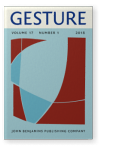Article published In:
GestureVol. 17:1 (2018) ► pp.128–157
The role of gestural polysigns and gestural sequences in teaching mathematical concepts
The case of halving
In this paper, we examine the conceptual pedagogical value of representational gestures in the context of teaching halving to first
graders. We use the concept of the ‘polysign’ as an analytical tool and introduce the notion of a ‘mathematics gesture sequence’
to assess the conceptual role gestures play in explicating mathematical concepts. In our study of four teachers each teaching a
lesson on halving, they produced representational polysign gestures that provided multiple layers of information, and chained
these gestures in mathematical gestural sequences to spatially represent the operation of halving. Their use of gestures and their
ability to use gestures accurately to convey mathematical concepts varied. During the lesson, learners, whose teachers used few
representational gestures or used gestures that were conceptually incongruent with the mathematical concept, expressed more
confusion than learners whose teachers used conceptually appropriate gestures. While confusion can be a productive part of the
learning process, our analysis shows that producing conceptually appropriate gestures may be important in mediating concepts and
the transition from concrete and personal symbolic processes to institutional mathematical signs.
Article outline
- Introduction
- The role of gesture in mathematics classes
- The polysign gesture: An analytical tool
- Methodology
- Teachers’ overall patterns of gesture use
- Representing the mathematical concept of halving in gesture
- The halving operation represented by polysigns being chained together
- From doubling to halving, using a MGS
- Halving using ambiguous polysign gestures
- Children’s responses to instructional input
- Conclusion
- Acknowledgements
-
References
References
Adámek, Jiri
(
1983)
Theory of mathematical structures. Dordrecht: D. Reidel Publishing Company.

Alibali, Martha W., Andrew G. Young, Noelle M. Crooks, Amelia Yeo, Matthew S. Wolfgram, Iasmine M. Ledesma, Mitchell J. Nathan, Ruth Breckinridge Church, & Eric J. Knuth
Alibali, Martha W., Mitchell J. Nathan, Ruth Breckinridge Church, Matthew S. Wolfgram, Suyeon Kim, & Eric J. Knuth
(
2013b)
Teachers’ gestures and speech in mathematics lessons: Forging common ground by resolving trouble spots.
ZDM: The International Journal on Mathematics Education, 451, 425–440.


Alibali, Martha W., Mitchell J. Nathan, Matthew S. Wolfgram, Ruth Breckinridge Church, Steven A. Jacobs, Chelsea Johnson Martinez, & Eric J. Knuth
(
2014)
How teachers link ideas in mathematics instruction using speech and gesture: A corpus analysis.
Cognition and Instruction, 32 (1), 65–100.


Baker, J. E., Maxim Bruckheimer, & H. Graham Flegg
(
1971)
A pedagogic approach to morphisms.
Educational Studies in Mathematics, 4 (2), 252–263.


Broaders, Sara C., Susan W. Cook, Zachary Mitchell, & Susan Goldin-Meadow
(
2007)
Making children gesture brings out implicit knowledge and leads to learning.
Journal of Experimental Psychology: General, 1361, 539–550.


Church, Ruth Breckinridge, Saba Ayman-Nolley, & Shahrzad Mahootian
(
2004)
The role of gesture in bilingual education: Does gesture enhance learning? International Journal of Bilingual Education and Bilingualism, 71, 303–319.


Colletta, Jean-Marc, Ramona Nkosinathi Kunene, Aurélie Venouil, Virginie Kaufmann, & Jean-Pascal Simon
(
2009)
Multi-track annotation of child language and gestures. In
Michael Kipp,
Jean-Claude Martin,
Patricia Paggio, &
Dirk Heylen (Eds.),
Multimodal corpora: From models of natural interactions to systems and applications (pp. 54–72). Berlin: Springer.


Cook, Susan W., Ryan G. Duffy, & Kimberly M. Fenn
(
2013)
Consolidation and transfer of learning after observing hand gesture.
Child Development, 84 (6), 1863–1871.


Cook, Susan W. & Susan Goldin-Meadow
(
2006)
The role of gesture in learning: Do children use their hands to change their minds? Journal of Cognition and Development, 71, 211–232.


Gallistel, Charles R. & Adam P. King
(
2009)
Memory and the computational brain: Why cognitive science will transform neuroscience. Chichester: Wiley-Blackwell.


Goldin-Meadow, Susan
(
2009)
How gesture promotes learning throughout childhood.
Child Development Perspectives, 31, 106–111.


Goldin-Meadow, Susan, Susan W. Cook, & Zachary P. Mitchell
(
2009)
Gesturing gives children new ideas about math.
Pyschological Science, 20 (3), 267–272.

Gullberg, Marianne
(
2006)
Some reasons for studying gesture and second language acquisition (Hommage à Adam Kendon).
International Review of Applied Linguistics, 441, 103–124.


Krause, Eugene F.
(
1969)
Homomorphism: A unifying concept,
Mathematics Teacher, 62 (8), 617–622.

Lakoff, George & Raphael Núñez
(
2000)
Where mathematics comes from: How the embodied mind brings mathematics into being. New York: Basic Books.

McNeill, David
(
1992)
Hand and mind: What gestures reveal about thought. Chicago, IL: University of Chicago Press.

Ping, Raedy & Susan Goldin-Meadow
(
2008)
Hands in the air: Using ungrounded iconic gestures to teach children conservation of quantity.
Developmental Psychology, 44 (5), 1277–1287.


Richland, Lindsey Engle
(
2015)
Linking gestures: Cross-cultural variation during instructional analogies.
Cognition and Instruction, 33 (4), 295–321.


Roth, Wolff-Michael
(
2001)
Their role in teaching and learning.
Review of Educational Research, 71 (3), 365–392.


Sime, Daniela
(
2006)
What do learners make of teachers’ gestures in the classroom? International Review of Applied Linguistics in Language Teaching, 44 (2), 211–230.


Singer, Melissa A. & Susan Goldin-Meadow
(
2005)
Children learn when their teachers’ gestures and speech differ.
Psychological Science, 161, 85–89.


Tellier, Marion
(
2008)
The effect of gestures on second language memorization by young children. In
Marianne Gullberg &
Kees de Bot (Eds.),
Special Issue: Gestures in language development. Gesture, 8 (2), 219–235.

Valenzeno, Laura, Martha W. Alibali, & Roberta L. Klatzky
(
2003)
Teachers’ gestures facilitate students’ learning: A lesson in symmetry.
Contemporary Educational Psychology, 281, 187–204.


Cited by
Cited by 1 other publications
Nathan, Mitchell J., Amelia Yeo, Rebecca Boncoddo, Autumn B. Hostetter & Martha W. Alibali
This list is based on CrossRef data as of 2 july 2024. Please note that it may not be complete. Sources presented here have been supplied by the respective publishers.
Any errors therein should be reported to them.
